BARBARA WASHBURN MtKittery
Midatlantic Director BARBARA WASHBURN
MtKittery
In the mid-70’s, our family (my husband Louie, the three kids, two domestic shorthairs, three show ponies and two ram- bunctious dogs) had moved to Malvern, Pennsylvania after Lou finished law school. We had plenty of room for more animals (at least I thought so), but Louie has always imposed a strict quota on the Washburn animal population. He thinks «give Bunty an inch, she’ll make a zoo». He knows me! In the Spring of 1975, we lost Duffie, our collie. Naturally my first thought was to get another dog, but I had be come intrigued with those huge shaggy Maines. When Lou said that I could have another cat if I gave up replacing the dog.
I went to Carol Nogle and purchased my first Maine-a female:Bo Chat’s Kennebec. I guess everyone must recognize that cattery name-Bo Chat’s Lord Chesterfield appears in a great many pedigrees. You won’t see my Kennebec in any pedigrees as she was an alter. But you may recog nize the name of my first breeder cat, Ktaadn Chel sea, who came from Liz Eastmans’s cattery. Chelsea joined the Washburn menagerie in 1977. You could say that she is the foundation of my cattery. And now at the age of 12 she is still in fine fettle and keeps the place free of rodents.
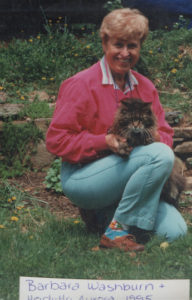
In 1979, SGC MtKittery Schoodic was born in a lit ter from Ktaadn Chelsea and Illya’s Shem. A num ber of notable cats are de scended from Schoodic and his two main «squeezes»: Heidi Ho Aurora and her sister Tanstaafl’s Molly Brown. (Other «clone» siblings of these girls at were TGC Heidi Ho Richard III of Charmalot, O.S, SGC Lady Arwen of Mary B, QGC Heidi Ho Coon Victoria, Heidi Ho Canth and Heidi Ho Camille). To list a few of Schoodic’s offspring: SGC Tanstaafl Druid of Seelieshire, SGC MtKittery Rumford, MtKittery Calais, SGC Tanstaafl Commodore of Willowplace, SGC Willowplace Lily Snow, SGC Tanstaafl Bacchus of Sophisticats, not to mention SGC MtKittery Mac wahoc. SGC MtKittery Penobscot, a National Award Winner for two years running and a recent CFA Grand Champion, is Schoodic’s grandson.

I have served the Maine Coon in several official capacities: I was the Northeastern Director for TICA for a number of years and am currently Midatlantic Director of MCBFA. As an «early» Maine Coon breeder I’ve seen the changes our breed has undergone in the last decade or so. Sometimes I Iwonder about the direction we’re going these days. I’m not talking about how the cats meet the stand ard-the cats just get better. But even though our breed has grown in refinement and now has a lot more show ring clout, I am sometimes dis mayed at the poor form and shoddy motivation we dis play as a group.
Back in the 70’s days for Maines-all the Coon breeder/exhibitors were friends. There were Ron and Betty Llostad, Mary Buck master, Helen and George Andre, Carol Nogle, Liz Eastman and Carol Ped ley…and others to numerous list here. We had the drive and determination to put the Maine that in it’s proper place in the spotlight, and we had a lot of fun in the process. A weekend a show was as much a social occasion as it was serious business. If, by some miracle, a Maine made a final, we all cheered like mad no matter whose cat it was.I wonder if we can preserve the unique spirit of fun that was so much a part of why I got started breeding in the first place. Can we keep our society of FRIENDS? I hope the answer is «YES».
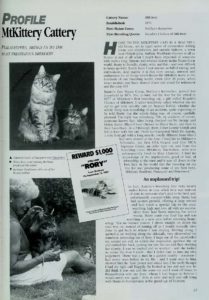
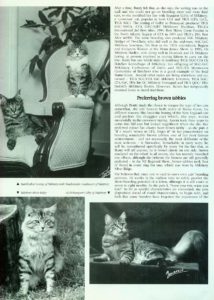
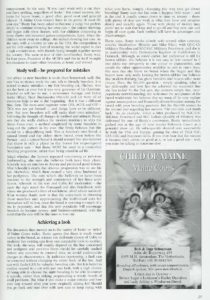
The Sracht Sheet spring 1989
You can read the interview of the photographs in pawpeds https://www.pawpeds.com/cms/index.php/en/breed-specific/breed-articles/mtkittery-cattery
GC SGC Mtkittery Warren Peace of Coons´kin
The Great Ham
GC SGC Mtkittery Warren Peace of Coons´kin
When Warren was around, everybody knew it. His presence literally commanded attention. He’d sashay. He’d swagger. He had a cool sense of self. He always looked like he was out to make an impression—- and he certainly did just that.
With a coat that could keep ten cats warm; long flowing britches, belly fur that draped to the ground, a mane that was the envy of the 42nd St. Library lions, a seriously square, strong-chinned jaw, a long, long tail over 5 inches wide and his perfect mackerel striped pattern, on a lovely warm brown background, his 20 pounds looked more like 30. When he «made big hands» his paws spread out far enough to easily cover the whole palm of my hand. He was tall and regal, very long, thick and strong. He was a very great big cat.

But what made people «ooo» and «ah,» once the initial shock of seeing such a big beautiful cat released them, was his demeanor. Until his last show-in which he told me in no un certain terms that he was finished with shows forever he loved the spectacle. Despite all the noise and congestion, he was so so relaxed, that he would lay on his back on the grooming table for me to comb his long fur wherever I pleased, no matter how many people were crowded around watching.
The public absolutely adored him. He was quite a showman, and in front of a crowd, up on that judging bench, he was in his glory strutting his stuff, hamming it up and show ing it all off.
The same was true when company came to the house. The more people the better. He would collect compliments and reward his admirers by jumping on their laps. Hide from company? Whatever for?

Neither would he hide from dogs. From the moment he entered my home, Warren was fast friends with Silvester, my 105 pound blue merle collie. In his later years, long after Silvester had passed away, Warren spent most of his time with his other best friend, Rontu, a Chinook dog. For a cat, Warren was remarkably accepting of individuals from non-feline species.
Warren was bred by Barbara (Bunty) Washburn of Mt. Kittery Maine Coons. He was 2nd pick of the litter (Henry of Advent Hill was first) but I couldn’t have been more thrilled to get him. What I saw in him was everything I wanted: an extremely typey Maine, more serious/big cat looking than sweet, but yet an overall friendly looking cat.
He had everything I ever dreamed of in a most perfect. His pedigree included many cats I loved. And to top it all off, he was a fantastic buddy, a lover, a comedian, an important part of my life. He came from a repeat breeding of GC/ GRC MtKittery Penobscot and SGC Kiskata Quoddy of MtKittery, who produced between them great kittens.

Warren never disap pointed me. Despite his size, at every stage he was always chiseled, always a visual pic ture of the standard. He grew to be exactly what I’d hoped for, a gorgeous beloved pet, a great show cat who was fun to show and travel with and a popular, enthusiastic stud cat. He kept his conformity to the standard of the breed his whole life long and passed on his good looks to all his progeny. I humbly submit that he has made an important contri bution to several different Maine Coon breed ing lines across the country.
With my beautiful Goldie, (SGC, GC Cow town’s Golden Nugget of Coons’kin), he sired SGC, Gr. Ch. Coons’kin’s Tall man, who earned several Best of Breed awards in his own brilliant but tragically short show career. Warren and Goldie made absolutely gor geous kittens together. Warren produced a great many beautiful Maine Coon cats, including many very successful show cats and countless beloved pets, whose owners still keep in touch with me and send me pictures and holiday cards with notes about their cats’ latest shenanigans.
When I remember Warren, I first remem ber how he felt when I held him. He was big, warm and heavy, soft but strong. His bones were thick and substantial. And when you held him, he never asked to be put down. He was a great snuggle-er. But more than any thing, I remember his personality. He was brave, expressive, demanding, ever-present, patient, affectionate, intelligent, sometimes wild and crazy and always so funny. He was a clown. He was a great friend and companion.
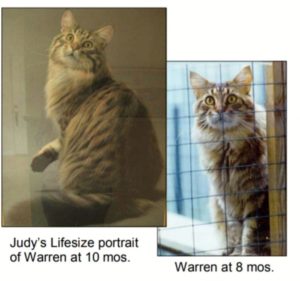
I remember his lying in front of the wood stove with Silvester, where they both slept away hours and hours. He played with the snow, pretending to be a great hunter in his outdoor run under the maple tree with a lake view. And I can still see him tearing through the house, up and down the stairs, streaking over furniture, leaping through the air to catch imaginary prey.
He never complained. He could take all the love you could give him. You could hold him like a baby and kiss him like you eat corn on the cob. Grooming for shows took quite a long time. With such a dense coat, the bath ing and drying could take hours. bath, wrapped up in the towels-well…you can’t describe how cute a cat can look. He put up with so much and he did it with dignityand patience.
I believe he understood a lot of English and he was always co operative because he understood me.
Warren passed away in 1997. I still miss him very much. A very large, beautiful por trait of him taken by Tetsu Yamazaki at the Madison Square show when Warren was only 10 months old hangs in a prominent place in my home. The photo is life size and so exquisitely sharp you can see each indi vidual hair. I stand in front of that picture and wish I could reach right through the glass reach up to heaven and hold him again.
Judy Friedman San Diego, CA.
The Scratch Sheet
Spring 2005
BARBARA RAY Willowplace
History and origins of Willowplace
Most people don’t know that Maine Coons were unknown for many years, even in the United States.
In the late 1960’s I picked up a beautiful brown with white classic torbie type female. My veterinarian estimated she must have been about two years old. She did not appear to have been spayed, so we waited some time to see if she was expecting kittens.
She looked very special and her character was absolutely adorable. I realized right away that someone had lost a very dear animal, but I never managed to find out where she came from.
I lived in a villa area with a lot of traffic, so we came to the conclusion that he had probably escaped from a car.
I was really panicking about the outside, as if she had never been outside before, so naturally I kept her indoors. To me and to all the people who saw her, she gave the impression of being a pedigree cat, although we didn’t know exactly to which breed she could belong.
After much searching and consulting dozens of cat books, I finally found one that identified the Maine Coon breed. The cat I had picked up looked like it was posed for the picture in the book. After this, at least I could tell people what kind of cat it was supposed to be. I can tell you that this was many, many years before I found anyone who had even heard of Maine Coon cats.

This gives you an idea of how rare this breed was in those days.
I took the cat to be spayed and upon spaying the vet discovered that she had ovarian cysts, so she would not have been able to have kittens even if she had been mounted. We never knew, therefore, if the previous owner intended her to breed or not.
Time passed and we both gained a few years and matured. I was so fascinated by her and her character that I started to get interested in Maine Coon breeding and read everything I could with following about this breed. I found it such an interesting breed that I thought it was worthwhile for more people to know about it.
It was not at all easy for me to find my first Maine Coon to breed because of the following factors:
1. The number of breeders of this breed was very few, so there were very few Maine Coons available, either as pets or for breeding.
2. My Maine Coon was a beauty. He had the characteristic expression, body, ears and lynx tufts similar to the Maine Coons we see today in cat shows. Unfortunately, it seemed difficult to find any cat of that breed for breeding whose quality could match my standards. I traveled around the country and visited the few breeders, but in general I did not like the cats for sale for breeding.
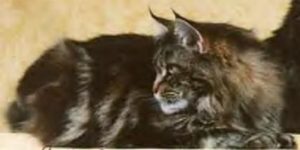
Ginny Molly had obtained a cat from a couple in Tennessee who had started breeding in the mid-1970s from the Sundar-Tati-Tan line. She reportedly sold this cat to a certain person on the West Coast and for some reason it was returned to her. I guess they had too many cats, or something. Ginny crossed this blue and white tabby with Heidi Ho Richard III of Charmelot and got a female kitten that in my opinion was good enough to start breeding.
I didn’t just want to breed Maine Coons. I knew exactly the look I wanted to achieve and I wasn’t going to settle for anything less. So, in 1981 I took this cat and crossed her from time to time with the Supreme Grand Champion «Tanstaafl Druid of Seelieshire».
<<Druid» had been Best Maine Coon in the puppy variety at the inter national level and was also Best Maine Coon International at TICA in 1983.
The crossbreeding of «Charmelot Katie of Willowplace» with «Transtaafl Druid of Seelieshire» produced a litter of four kittens, two of which were Supreme Grand Champions at TICA.
One of the kittens, «Willowplace Lilly Snow» was Supreme Grand Champion and Outstanding Dam, and was the first Maine Coon female in the history of Maine Coons to place in the top 20 most awarded cats among all breeds in the world. In 1984 and 1985 she was the Best Maine Coon female at the inter national level and 17th Best Cat among all the breeds in the world.
<<Willowplace Starbuck» was the first son of «Willowplace Lilly Snow». He was Grand Champion and in 1986-87 was 15th Best Cat International at TICA.
In her next litter «Willowplace Lilly Snow» produced «Willowlpace Magic» who was Supreme Grand Champion and Outstanding Dam, «Magic» still holds the title for being the most awarded Maine Coon female worldwide. In 1987-88 she was Best Maine Coon International (males and females competed against each other in TICA and she was Best of both sexes) and 4th Best Cat International of all breeds in TICA.
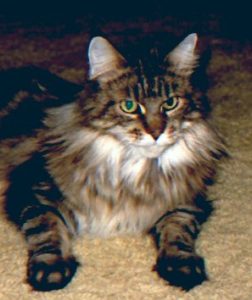
The following year, another of Lilly Snow’s daughters named «Willowplace Renaissance Woman», was Best Maine Coon female and 16th Best International All Breed Cat.
In the same year Starbuc’s daughter «Willowplace A Magic Star Is Born» was born, who was Supreme Grand Champion and Maine Coon International of the Year puppy class and became 1990-91 Best Maine Coon female and 11th Best Cat International All Breed at TICA.
<<<<Magic Star>> is the grandmother and «Lilly Snow» the great grandmother of Supreme Grand Champion <<<Masaïtana Haut Brion of Wil lowplace».
It was a great pleasure for me to bring this cat home from Bordeaux, France, in October 1995. This huge and beautiful male Maine Coon brown tabby/white was bred by my friends Marianne and Hervé Simon.
He is the first non-imported Maine Coon America cat to achieve the title of Supreme Grand Champion here in the United States. He has also been a wonderful breeding cat for us.
My husband, Cliff Scrutchin, works with me at the Willow place cattery. He loves cats as much as I do and helps me a lot with them and the kittens.
Thanks to his support I am able to breed, enter the cats in shows and even occasionally take long trips to participate in judging. He always stays at home and takes care of the cats for me.
Initially, my first Maine Coon registered to breed was Grand Champion and Outstanding Dam Charmalot Katie from Willowplace.
I continued to breed cats of this breed in honor of the Maine Coon I rescued at least 10 years earlier that made me adore that look and character unique to that breed.
I am currently an Allbreed Judge for the International Cat Association. To achieve allbreed status, I must live with and exhibit a variety of breeds over a period of several years. I do not have to breed other breeds, I just have to live with them, give Grand Champion awards, etc.
I love all cats, but seriously, there is nothing in the world like a Maine Coon cat. I tell people that if they ever had a Maine Coon they would no longer want to have a different cat.
I love handling and judging all breeds of cats, but I can’t imagine breeding anything but Maine Coon cats.
And now a piece of advice for those countries that are going to start breeding Maine Coon cats: It is advisable to make sure and check references, import from breeders of recognized reputation for having HEALTHY CATS and having obtained a fair evaluation in contests.
It is advisable, if possible, to have in each country as much genetic diversity as possible for breeding. Many of the head lines have similar pedigrees, even if they are from different catteries.
So, buying a cat from a different breeder does not always ensure that the breeding lines are different.
If you already have a breeding cat and are introducing a new cat to the household, isolate the cat or kitten for 6 to 8 weeks if possible. This may seem radical, but it will prevent the transmission of possible diseases in the cattery. This isolation will not necessarily be in a cage, it will be enough to introduce the new cat in a different room or area of the house. After 6 to 8 weeks you will be able to determine if you have imported a healthy cat.
More tips:
Black tabby and black tabby with white are probably the most successful colors in the Maine Coon breed. They are two good colors to start with. In addition, these colors have been much better quality than all other colors. I tell you this because black tabby is my favorite color. I currently breed Maine Coon in all colors, within certain limits.
I started with brown tabby and brown tabby/white tabby, which made it much easier for me.

It is easier to get a good one of these types from the cattery than any other color, although of course this is not a fixed rule.
If you want to work with other colors as well, be sure to have a typical black tabby or black tabby with white with very large bones to be part of the breeding program and cross it with the other colors.
Avoid crossing too close relatives, as this can end up weakening the immune system of the resulting offspring. Work with reputable Maine Coon breeders. Well, here are some of my secrets.
If you can, go to shows and see the potential candidates live before making a decision.
Work with breeders who understand and can explain the pedigrees to you. All the pedigrees coming from breeders can seem confusing to beginners, so don’t mind asking too many obvious questions. Ask as many questions as you can think of, as this is the best way to learn. I can say that since 1983 I have shipped Maine Coons to 16 or 17 countries, including Japan and Hong Kong.
I started with a small breeding program and continued this way for many years. I think it is better to take small steps, slowly and learn, than to jump in and buy a lot of Maine Coons from the beginning. Go slowly and make sure what you really like, what colors you prefer. Learn every day a little more about the breed and pedigrees.
There are many Maine Coon breeders in the United States today. Not so long ago there were so few that they all knew each other. Now this has changed. I don’t even know everyone in my area. Many times I am asked about breeders I have never even heard of. Of course, this is not to say that they are not good, but simply that there are so many of us in the United States.
In general in many shows there are more Maine Coon cats entered than any other single breed. There are many beautiful Maine Coons in many different colors.
My husband, Cliff Scrut chin, and I live in Green ville in South Carolina in the southern United States. Our house is full of Maine Coons and we also have a 14 year old Siamese that Cliff rescued 14 years ago from a pet store.
Lilly Snow, my all time favorite cat, is 14 years old and sleeps with me every night. We love having the cats and watching the puppies grow up.
SONYA STANISLOW Tati-Tan
«When Dauphin was awarded Best Cat, I was in a state of euphoria, but this was short-lived. Many longhair breeders objected to the outcome of the judging and more or less demanded that he be recalled to the ring to determine if he indeed met the standard and was not slipping by with some disqualifying fault like polydactylism. As a matter of fact, Dauphin was called back to the ring not once but THREE times. The judge finally faced the crowd and said, «Sorry, this cat is still my best in show». It should have been a happy time, but before long I was literally crying my eyes out because so many breeders were so angry over the judge’s decision.
The situation did not change from show to show and my Maines’ wins were met with great opposition. Many times I heard Dauphin referred to as «that garbage can cat» or «that long-haired stray». These comments weren’t made exactly sotto voce either! But as the saying goes, when the going gets tough, the tough get going
In the late ’60’s you had your choice of either ACA or CCA since they were the only Associations that accepted our breed for Championship competition at that time. I showed in both. The most vivid memories of that period are of the trips up into Canada for the Canadian Cat Club shows. Imagine lugging three cats on the train from New York City to Toronto! A lot of work, but a lot of fun too
Promoting a breed to Championship is an expensive proposi tion. I figure that in 1968, I exhausted approximately $10,000, all I had in my savings account.
Little do the breeders of today realize what a hard uphill battle was fought for recognition of this breed
Well, the rest is all history…today our exquisite cats are beginning to command the respect they so richly deserve.»
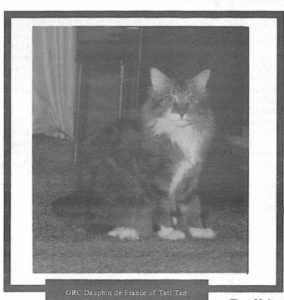
The Maine Coon Cat
by Sonya Stanislow
Myths, legend and lore surround the Maine, Shag or American Longhair cat. Some are amusing, some are fantastic flights of fan tasy and some are merely plausible. They certainly provide good material for conversation. Books and articles dealing with these aspects of the Maine Coon have been well received as people never seem to tire of the subject and are always eager to know more about this wonderful breed.
I don’t intend to restate all that has been said in print already. Suffice to say, prior to its acceptance in the cat fancy as a registerable cat, the Maine Coon occurred ‘naturally’ in the Northeastern areas of the United States and Canada. Often referred to as a «Shag Cat» by local residents, the Maine Coon has always been highly prized both as a working animal and valued pet. Through its own mysterious breeding program, nature had produced a sturdy cat that was ideally suited to the harsh winters and varied seasons of the region. In addition, the cat’s good nature, intelligence and «dog-like» characteristics made it a very popular and sought-after feline on.
Of course, the Maine was always regarded for its beauty. In the first cat show ever held in this country, a Maine Coon was chosen as the best cat. Yet, despite these recommendations there was little interest shown in the Maine Coon by people involved in breeding purebred cats. And for many years, while breeders worked with foreign exotic cats, the native American longhaired cat was conspicuously absent from the showhall.
The Maine’s evolution from farm and backyard cat to a CFA finalist was not an easy one. Nor did it happen quickly. In fact, it has been a lengthy journey and it’s the story I’d like to tell at this time.
In 1962, I went to visit an old friend who was living in Upstate New York. When I walked into the house, I was stopped in my tracks by one of the biggest most beautiful cats I had ever seen. It was love at first sight. And it was mutual! That cat, which turned out to be «just a Maine Coon kitten» left with me when I returned to New York City.
Something had been released in me that I previously hadn’t known was there. I had always been a cat lover but this was different. I wanted to know everything about this breed and began seeking out what information was available and people who knew anything about them. Believe me, it wasn’t easy.
Everything finally fell in place when a friend of mine, who knew I was working on this project, told me that there was a cat show going on at the old Armory on 34th St., New York City. Well, I had never been to a cat show before and I have to tell you, it was an experience I’ll never forget!.
I wandered around. I watched the judging and talked to people about cats for hours. But the thing I remember most vividly was walking by an «Exhibition» cage and seeing a full grown Maine Coon that was identical to my own little kitten.
Perhaps I am the person responsible for the joke all Maine Coon breeders tell: «So that’s a Maine Coon,» I remarked, «Well I’ve got one at home just like it.» Except. that back then there were no Maine Coon breeders in CFA and the only place anyone had a Maine Coon was at home.
Back in the ’60’s, I think it would be fair to say that Maine Coon breeders were very few and very far be tween. There were some terrific people fighting the good fight for the Maine Coon then…Mrs. Whittemore, Lillias Vanderhoff, Nancy Silsbee, Rose Levy, Henrietta O’Neill, Mr. and Mrs. Eminhizer and, if you don’t mind, yours truly. If it had not been for the hard work and per severance of this group and some others I don’t have space to mention, the Maine Coon would probably still be out in the barn.
Promoting a breed for championship competition is not easy. It is expensive and time consuming and doesn’t lack for disappointments, opposition, and occasionally, ridicule.
It will always be a mystery to me that Americans look down on their «own» and revere things with foreign origins. Aren’t Siamese, Korats, Japanese Bobtails, etc.. etc., etc., the Maine Coons of their lands? A cat, to me, should always be judged on its own merit. Where it comes from or what it’s called shouldn’t influence. anyone. I have always been able to appreciate the «majes ty» of a good Persian or the «elegance» of a good Siamese. But it took a long time for many people to appreciate the «presence» of the Maine Coon.
I guess I’m just a feisty person. The more someone tells me «NO», the harder I fight. This must be a trademark of Maine Coon breeders. Because back then, we all spent endless hours writing proposals and cor responding with people to request and push for the re-acceptance of the Maine Coon in championship class. Of course, I look around at the shows today and see the great classes of Maine Coon and I know that it was all worth it. But at that time it was a lot of plain old hard work.65
COURTESY OF THE CFA ANNUAL YEARBOOK 1985 with permission of the Cat Fanciers’ Association and the Author
Scrath Sheet spring 1989
SONYA STANISLOW
As told by Sonya
I would like to take you on a journey into the past, but first, a detour. It was 1965 and a friend invited me to visit my first cat show. While browsing around, I suddenly came to an abrupt halt. There before me was this remarkably beau tiful Maine Coonidentical to the cat, Tanya, I had at home. I whipped out a photo from my purse and the owner agreed that there was a definite similarity. The breeder was pleasant and chatty, answering my various questions. She was very informative and outlined in detail how I should proceed in showing my cat in the future. She did, however mention that this breed was not yet recognized forchampionship competition. Visiting this show marked a turning point in my life and now for that journey.
I was fortunate in locating a veterinarian who was exceptionally knowledgeable in pre paring a cat prior to showing. After a thorough examination, he asked me what my plans were for Tanya. I told him I was interested in exhibitingher for competition. He instructed me to run my hand across her back and report what I felt. «Lumps!» was my response. He advised me to return home and groom this cat until there was not a hair left on the comb. «Return in one week and if I don’t notice a decided improvement in her appearance, I will personally toss your butt out of my office.» He was dead serious, and I was both angry and terrified. In a week’s time, I had combed out enough mats and fur to make a small pillow. The end result was more than gratifying. When I returned to his office, he failed to recognize her, so I knew that my efforts were well Regional Award compensated. The year is 1966; the place–the old Madison Square Garden in New York City. All cats being shown had to pass a veterinarian inspection at the show hall. Tanya was entered as a longhaired household pet. She had wonderful show presence and amenable to handling. She fared so well in the judging rings that the judge, the cat and I were televised that weekend.

This was not sufficient to satisfy me. The acceptance of this breed became an obsession with me. I felt compelled to pursue that goal at any cost. The following year, 1967, my Dauphin de France was bom (Kris Kringle X Petite Bon-Bon). Little did I realize that I was ahead of my time when I bred this stunning creature. He closely conformed to the standards of today. I registered my cats and cattery with every active association including Canada. I joined cat clubs, attended meetings, some of which were 8-9 hours from home, only to return with empty promises.
No other Maines were being shown, so I provided my own competi tion. At the request of some associations, I was encouraged to bring them in for exhibition only. The reaction of the spectators, which was favorable in every respect, prompted me to continue my cam paign. Very few breeders were eager to guide me in the proper direction. One Siamese breeder, ac tive in CFA whom I befriended, arranged to have one of my Maines appear on a live TV show (The Today Show). Bijou was a natural. I was so proud of him as I watched him on the huge color screen, while my face flooded with tears. Later there was a press conference and his photo chosen to appear in the daily news. I thought my son had taken on a paper route when he appeared that evening loaded down with a heap of newspapers.
One evening as I sat down to read «CATS Maga zine» that had just arrived, I felt as though struck by a bolt of lightning. There in black and white– «The Maine Coon has now been accepted by both ACA and CCA for Championship status.» My frustra tions released. I was ecstatic!
In 1968, I entered my first championship show (ACA) bringing my own competition. It surprised me that no other Maines were entered. I showed Dauphin, who by now was a promising adult, his «wife», Tatiana, Tanya and last but not least, my silver tabby American Shorthair, Pushkin. I would like to note that I did not own a car(and still don’t), so depended solely upon friends, railroad or rented a stationwagon, with a friend to drive me. When the Finals were announced in the first ring, all pandemonium broke loose. Dauphin was awarded Best Maine, Best Novice, Best Longhair, and finally, Best Cat. To add insult to injury, Pushkin made a Best Cat win in the Shorthair Division.

Needless to say, not a soul spoke to me and many longhair breeders demanded that Dauphin be recalled in hopes that the judge would locate at least one fault to rescind his monumental wins. The judge was firm and stood by his conviction repeating that there was no reason to fault him. The cats were overwhelmed with awards, which included rosettes, tro phies and monetary prizes. The final outcome of my first show managed to generate a tre mendous amount of hostility toward me and my felines.
I continued showing and in 1970 embarked on a long and tedious journey to Canada by railroad to show Dauphin and his red tabby son, Bijou. Since it was a one-day show, we left in the morning and returned home that evening. Again, no other Maines were in com petition. We were well received and genu inely felt welcome. Dauphin was Best Open; both he and Bijou were now International Champions.
My Siamese breeder friend persuaded me to enter the Manchester, NH show. Once again, I transported my entourage of competition. Murphy’s Law must have been working overtime. Prior to reaching the show hotel, the car battery died. Finally arriving, I unlocked the hotel room door and instead of breathing a sigh of relief, I gasped at the sight of a man’s clothing laid out on the bed with strains of «tenor operatics» coming from the bathroom shower. The Reservation Clerk had erroneously assigned my room to another. They transferred me to the last available room, which had a missing pane of glass in the window. My only remaining solution was to confine the cats comfortably in the bathroom. But there was no door. After such a lengthy trip, there was no confining them to their carriers. I ended up keeping a vigil on the cats and the window all night. By moming, I couldn’t locate them and was gripped with panic. After literally tearing the room apart, my friends and I discovered that they had burrowed a hole in the box spring and snuggled in. All were accounted for except my Pushkin. I rushed out into the hall in time to see him enter an open elevator. The doors closed and down he went. As I attempted to locate the stairwell, the elevator came back up and off walked my cat completely calm and unaffected by his adventure.
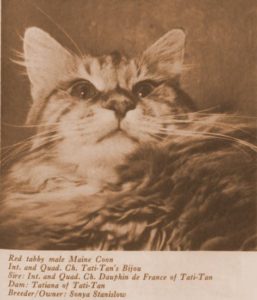
I was informed that this was a first for Maines -being shown in New Hampshire. My cages were constantly surrounded by admiring and curious individuals as I stood in the background absorbing the scene. Sometime during the show, I was approached by a person with a micro phone, who asked why the acceptance of this breed was delayed for so long. My response came quickly and candidly that Persian breeders reluctantly opposed the competition, much less welcomed other longhairs infringing on their ter ritory. Little did I know that this was part of a radio broadcast, later repeated over the show hall PA system for all to hear.
By now, I was programmed not to be intimi dated by any derogatory comments or conde scending glances. To sum it up–when the going gets tough, the tough get going. My life became one adventure after another and in between, I managed to judge a couple of household pet shows.
When other Maine Coon breeders began to surface, I had to endure unnecessary, unpleasant comments about my cats and myself personally. The more wins my felines accumulated, the more trying the situation became. As I traveled from show to show, I could hear whispers, «That cat,Dauphin, is here,» or «Here comes that crazy lady with her Maine Coons.» I braved a second trip to Canada in 1972 at which time there were now seven Maines entered from three breeders. Tony Morace, who is currently an ACFA Judge, andDeborah Hoyt joined me. We all had a good time at this show. At the Boston Show, Dauphin succeeded again to make a Best Cat win. Tony and Deborah had also entered their cats. History repeated itself-the Persian breeders raised an objection to Dauphin’s win, which remained unchanged. It wasn’t always Persian breeders. Once, my cat needed one BOB Champion win to Grand. He got it, only to have a Maine Coonbreeder protest it. The judge removed the ribbon and gave it to the other exhibitor. A counter-protest was to no avail. Eventually ICF, ACFA and CFF opened their doors to the Maines. In 1972, I joined an ACFA club and subsequently voted in as President of The Friendly Felines Cat Club. March 11-12th of that year, we put on a «show of shows» in Long Island City. We were instrumental in having what was prob ably the biggest Maine Coon entry since their recognition–23 adults comprising the following catteries: Mor-Ace, Norwynde, Tati-Tan, War-Tell, and Quan-Yin.
In the early years, we had a mixed bag of Maines. Most of the heads were rounder. Some had lengthy bodies; others, cobbier. The expres sions were sweeter and had abundant coat in comparison to the current types. Noses came in a variety from long straight to slightly concave to short with a decided break. Ears ranged from short to tall. There wasn’t the definition of classes as we have today. Any cat with white was thrown into the particolor class, i.e. rather than specify tabby w/white, the patched tabbies were classified as torbies.
The major problem was greasy coat and obviously we knew little about proper bathing. One judge finally commented on this fault and slowly we strived for improvement.
Although the Maines have gained their long-overdue rightful place among the other greats, our problems are far from over. There are still divergent opinions about the Maine Coon Standard. Many who have been around the show circuit for a good length of time have evidenced changes in predominantly two breeds–the Persians and the Siamese. I have always supported improvement, but what I currently observe is an effort to drastically alter the appearance of the Maine Coon, perhaps to the point of no return. As a direct result of repeated inbreeding, longevity can no longer be applied to our feline friend. I myself was offered a female who produced two cardiomyopathic kittens in one litter, both of which expired before they reached nine months of age. Her pedigree revealed an alarming amount of inbreeding and rather than experience future loss and tragic deaths, she was spayed.
In the thirty years that I have been breeding, I have received many inquiries about purchasing a kitten that will eventually attain 35-40 pounds a s adults. My immediate reponse is that they check out their local zoo. Any breeder who guarantees size is not being honest. To repeat what I have stated many years ago, we are again sacrificing type for size. The Maine Coon is a domestic cat and not intended to house the physical structure and weight of its ancestor, the Lynx Cat, even though both sport lynx tips. Attempting to create a much larger cat could be detrimental to its normal physical functions and could partially be responsible for the hip dysplasia that is now apparent in some of our Maines.
Some breeders are currently breeding Maines with longer muzzl probably an attempt to give them a dog-like appearance. The sweet expressions, once a revered integral part of this feline, is too quickly fading into a feature of the past. Throughout history, man has always had the compulsion to change or destroy that which is beautiful.
The breeders of today little realize or comprehend the effort throug sweat and tears, let alone financial stress directed at removing this uniqu cat from the barm. Don’t put him back.»
Sonya Stanislow has slowed little. She is a full-time nurse in gastroenterology and cardiology practice. When asked to write the memories and thoughts, she and Mrs. Whittemore were eager to do so And they hand-wrote page upon page of information. That’s how mud they care for our breed and want to share with you. There are many strom and forthright statements in Sonya’s article, but that’s the kind of person took to ramrod our breed up the ladder to acceptance. You may still cal an occasional judge holding back, reticent to even touch a Maine Coon and hastily return it to its cage. We are carrying on Sonya’s and the other pioneer work even today.
Sonya continues to show (when a friend will provide transportation and occasionally judges a Household Pet ring here and there)
SONYA STANISLOW and Tati-Tan Remembered...
Sonya Stanislaw of Tati-Tan Cattery died on February 1 of this year. She had been living with her son, Dennis, and his family in New York when she became so ill she had to go to the hospital. Her last litter had been born in January of 1999 while she was still living in Wanaque, New Jersey. How ever, when she had to move to New York she could not look after another litter, although, as she told friends, she always had it on her mind. After her death, her son found homes for some of her coonies, kept some-especially the older ones and placed some with other breeders. Below are some notes from some of the people who knew her and had some of her pedigrees. Well, to tell the truth, I doubt there are very many Maine Coons out there who don’t have some Tati-Tan in their pedigrees.

It was in 1996, when we had the pleasure to get two of her girls, Tati-Tan’s Chanteuse (tortie/white) and Chansonette (black and white). Originally it had been planned that only Chanteuse was to come, but as Sonya was anxious about Chanteuse traveling alone-we arranged for her to be accom panied by her sister, Tati-Tan’s Chansonette. Sonya told us she had only once sent one of her animals to Europe: to England. And she did not like the stress so far for her Coonies. (And she was probably stressed herself, as she was very upset and nervous all the time till the two arrived well here in Austria.) We were so happy she made thisone exception for us! Chanteuse is-as she said-one of her most beautiful animals brought forth in her cattery.
For us she is invaluable, of course. Moreover Sonya has become very dear to us as a person. I have preserved her letters: There are about 90 that have crossed the ocean in these 5 years. We could [vicariously] participate in her suc cesses in shows (that was important for her all her life) and we tried to let her participate in our family’s life.
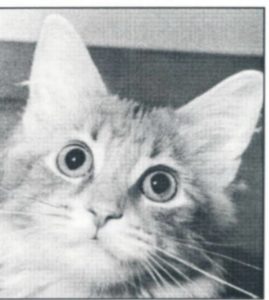
After her 70th birthday, she moved from Long Island to Wanaque, New Jersey She had been looking forward to this very much. On her 73rd birthday, she experienced harder pains for the first time. «I strained my back and I’m going through severe pain…» She wrote. Nobody then could be thinking it was the beginning of a cruel life of suffering. Then together with her backaches, she had very hard pains in her arms that was diagnosed as shingles. To add to it, came the unexpected death of her landiord and the stress of moving again, together with her Coons. That was in April of 2000 Now she was living with her son in New York, who was looking after her and her animals in her illness. But first she still has plans in her mind for showing her cats. But her pains became heavier. Unfortunately, her illness has not been shingles only.
Sonya’s last letter came in September 2000. A very short letter. «I am currently confined to bed unable to sit or walk due to painful low back. The cats are doing well and great company and very consoling…More. when I can. She could not. After that we were phoning, but she could not write any more. In January 2001, I got a mes sage from her son that Sonya was very bad and she had to be brought into a hospital I am very grateful that besides his mother and his work, he took time for this On February 1st, Sonya left our world. She for long had become part of our family. In the last years, we were sharing pleasures and griefs. She always will stay in our hearts. She has been a unique and grand breeder. All her affection and all her life belonged to her Maine Coons, being always prepared to give her ultimate to them. Over the Rainbow Bridge she must have been awaited by whomever she had donated her love.
One of Chanteuse’s daughters we are breeding with had her last litter on Sonya’s last birthday. Out of this litter we are keeping one female.

Recollections of Sonya and Tati-Tan
From Judith Schultz in Canada: I have cherished Tati-Tan cats for many years for their longevity, vigor and intelligence. My first personal connection with Tati-Tan was in 1996-1997 through Mary Jayne Franz from Franmar Cattery. Mary Jayne still has some of those old Tati-Tan offspring who are now 15, 16 and up to 18 years old. She used to tell me: «Judith, you can inbreed Tati-Tan cats until the cows come home and nothing bad will happen.» Of course, we know nowadays that too much inbreeding is not a good thing but this statement does mean some thing and her words stuck with me ever since.
This line originated in New Jersey, which adds even more sentimental value. It is recognized among very few of us as one of the oldest and healthiest lines in our breed. Tati-Tan cats were and still are extremely smart, social and gentle. Most of them can open cookie jars. A lot of them can jump so high some of my pet owners think they have a Cheetah in a Maine Coon coat. Tati Tans are fantastic mothers with so much milk, they could easily feed 25 kittens at once. (Honestly!) their milk pockets are filled right up to bursting til under their forepaws. Even though Sonja, like most breeders at that time did quite a bit of inbreeding, Tati-Tan cats have always kept their healthy gums and teeth.
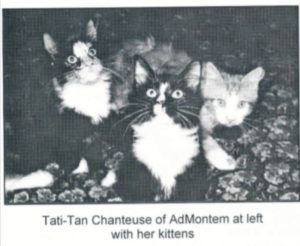
Most people did not want much Tati-Tan in their pedigrees because these cats did not produce Moun tain lines. So, the Heidi Ho content increased and the Tati-Tan content diminished over time. Tati-Tan cats are small but not lightly boned. They have strong, long bodies. I actually believe that it was the Tati-Tan line that brought the nice body length into our breed be sides many other desirable traits.
I feel extremely blessed to continue with the lines of Sonja Stanislaw. I own GCH Tati-Tan’s Silhouette and GCH Tati-Tan’s Cloche, two of Sonja’s oldtimers.
Nowadays Tati-Tans have been crossed to other lines of course. Even though they do not present a sufficient outcross to most full pedi greed cats in our breed at this point, their very low clone percentage (as low as 3%) can add great value to our breeding programs. Since Sonja crossed over to Sonkey Bill offspring over the past years, there has been problems with hips, kidneys and hearts as well. So all cats from this line must be of course tested for HCM,PKD and HD. Judith Shultz PrairieBaby Maine Coons.
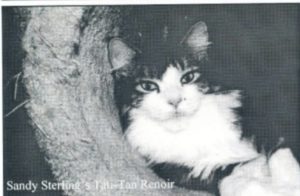
From Laura Cunningham:
I first spoke to Sonia Stanislaw at the very be ginning of Maine Coon International’s debut. Sonia called me with some questions and as we spoke, I realized ‘just’ to whom I was talking. What an honor and a thrill to be speaking to a ‘legendary’ breeder. Sonia told me about showing her early cats, and how she did not drive and had to take trains or rely on friends for transportation.
IMCI wanted to do a profile on Sonia and I helped ‘borrow’ a slew of wonderful photos of her Tati-Tan cats like Dauphin de France and Tatiana. It was very educational and enjoyable. They are featured in issue #4 of Maine Coon International.
It was always a pleasure to speak with Sonia. We spoke approximately 5 times. She was still ac tively breeding and showing her Maine Coons and was proud of her pedigrees and lines.
Her passing is a great loss to the Maine Coon world.
Laura Cunningham Coonyham Maine Coons
For those of you not familiar with Tati-Tan and Sonya, Cathy Glynn writes: «In 1968, the work on the breed began in earnest with the formation of a small but dedicated group: Ethelyn Whittemore, Nancy Silsbee, Rose Levy, Mr. And Mrs. Emin hizer, Henrietta O’Neil and Lilias Vanderhoff-who with help from the others, set about bringing the Maine Coon back to the popularity it had briefly en joyed in the early 20th Century. They found them selves fighting, at the time, breeders of other long haired breeds, the show judges and the system it self. As Sonya said, it is difficult to know why peo ple generally disparage anything close to home, when it is the very thing of which they would proba bly be most proud, but that is what happened.
The more exotic breeds had by then taken over in popu larity and it was a hard task to get anyone to accept that the Maine Coon was anything other than a barn cat… Sonya admitted-but usually in very amusing terms-that this was a difficult time, with acrimoni ous disputes brought on by tiredness and frustra tion, but they-and the cat-and all of us-were winners eventually, with a show standard which has changed very little to this day, although the breed itself has developed over the years. While all of this was happening, Sonya was also writing letter after letter, begging and bullying anyone who would listen to reinstate the Maine Coon as a championship breed-which at last happened, gradually over a period of time and the rest, as they say, is history!» Amen
Ed. From Roswitha Helfgott of AdMontem Cattery in Austria
More about Sonya here http://www.maine-coon.at/tati-tan1.html
ELISABETH MORCEL Kreiz ar Mor
I am a Maine Coon Breeder «by accident since January 1995, but at first I was like many, a cat lover without any knowledge about breeding and pedigreed cats, and I considered neutering or spaying a cat was against nature, and that it should not be done. I could not understand as well that an animal like a cat or a dog could be sold.
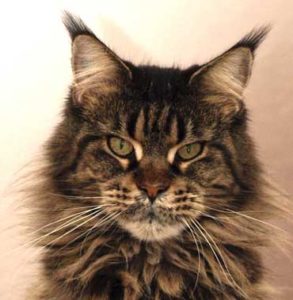
OLYMPUS DIGITAL CAMERA
Masaïtana R’Morrigane of Kreiz Ar Mor
In the 90’s, after many years without a cat. I took a black and white house neutered boy from a shelter. He brought me back the desire for kittens. I then decided that if I did not want my babies to be thrown in the ditches when people left for holidays, I had to have a pedigreed dam, for people who would have paid for a baby would really desire her or him, and would take care of the kitten.
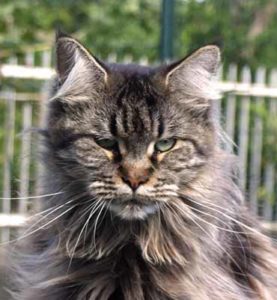
OLYMPUS DIGITAL CAMERA
Mystery Coons Yuna Madalenn P. of Kreiz Ar Mor.
I joined a cat club, and began the quest for my breed. It was rather quickly decided that I would have a Maine Coon. For the club, I translated breed standards from English into French and it helped me a lot. The club president was a very good s a very good SLH judge, who advised about the types. me about visiting shows, I had found f my future girl. She was born 2 years After the breeder of my November 1994. I just loved her, and I still miss her. She crossed the rainbow still miss her. She bridge 1 1/2 years ago at the age of 13, She never a gave me a baby but she inoculated me the «Coons tas involved myself in the club life. part to the shows organisation, and attending shows myself, most of the time helping as a clerk. Thanks to clerking, I leamed a lot about the other breeds too.
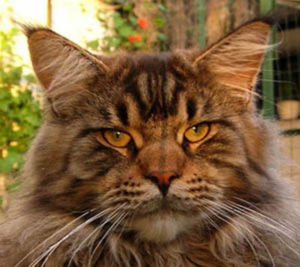
Superstar’s Finngall of Kreiz Ar More
In 1996 was bom my first boy, my old pal, a brown classic tabby teddy bear who unfortunately was sick when travelling which caused a lot of trouble when I arrived at shows, having first to g groom him again very quickly in the toilets. He is heterozygous to the MYBPC3 mutation and is now neutered. He is happily spending his time between my bed and the garden, with the other members of the crew, oldies and breeding cats.
I first heard of poly coons by reading the article written by Janet Marr in Maine Coon International, in 1995 and I then decided I would have one when I would be able to After a disastrous try in 2004 with a dishon est breeder, my first poly girl, DK Mystery Coons Yuna Madalen P arrived in 2005. NZ»MainlyMagic Anwen P arrived in March 2007 after a long trip from New-Zealand, partly with her brother, a non poly boy who is now living in continental France at a friend of mines, partly with me since I fetched her in Paris. Besides being a poly, she is my first outcross Coon.
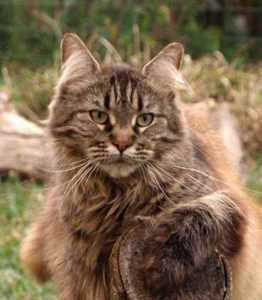
OLYMPUS DIGITAL CAMERA
I suppose I also have to say I am a member of the team of translators for Pawpeds. Of course I am myself looking all the time for any information I can find about the Coons, to help in my breeding program, el me in since now am a passionate breeder and only a not cat fancier. It is a bit difficult to do what I cat good work, because I don’t re- consider a I home my oldies, but anyway I progress, also to my thanks companion, a Maine Coon name «Seizh Aver». We breeder with cattery name met thanks to Coons and now are are working together, sharing «resources», but each of us , of us has his definite views of the type and kind of of is Coons he wants to breed. For example, he a fanatic of brown tabbies blotched with the wild look, and I like nearly all the colours, especially silvers.
By the my two last way, my two last cats should arrive in 2009 and both will be silver: a silver mackerel boy from traditional lines and a polydactyl silver torbie girl from outcross lines. Then, I consider I shall have enough cats and lines to prepare my own witch’s brew.Island, a small French overseas department (650 000 inhabitants) in the Southerm Hemi sphere, where I el brought all my older cats with me when I moved.
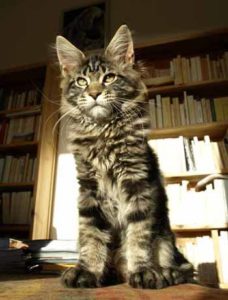
OLYMPUS DIGITAL CAMERA
Kreiz ar Mor Dwyn
By the way, by a strange wave of the destiny, my cattery name means «The middle of the sea» This name suits to the island I am living on, a tiny rock lost in t name clearly lost in the Indian Ocean, but I chose it many years ago, when I would have laughed at anybody who would have told me I would ally oddy one day be living here. Most of my babies join their new families in Europe, by plane, (one is in South Africa, some of them are in continental France and in other European Countries), one of them F»Kreiz ar Mor Calinka P happens to be the first polydactyl Coon in Russia.
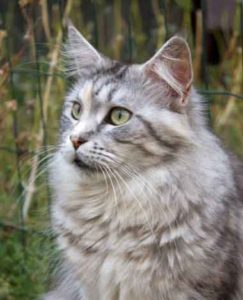
At last, I am a member of the Board, and now Vice-President of one of the two very small French Maine Coon Fanciers clubs (about 40 members each… compared with more than 360 breeders or so-called breeders). Profes sionally, I am working as a manager secre tary in a big company which produces and sells cement, aggregates, etc.
I would like to warmly thank Win and George Day, who reminded me of my old dream to join the MCBFA and offered to be my spon sors, and Misha Peersmans for her friendly support.
See more of the cats of Kreiz ar Mor cattery cats at
St Clouds & Coonyham
Laura Cunningham, Breeder Member, California
Nancy Davenport sold us our first Maine Coon kitten. We’d driven six hours from Northern California to her home in Culver City to buy a pet Maine Coon on Memo rial Day weekend 1989. We just wanted a male silver tabby of some kind – had no idea what patterns were or what «with white meant. Nancy had 13 kittens available (Moonshine had been very busy) but only two were both male and silvered (both were blue silver mackerel tabbies with white). While we decided which kitten to choose, one of Nancy’s females went into labor. In an interesting coincidence, St Clouds Serenade deliv ered four kittens while we waited and we saw St. Clouds Buckwheat and St Clouds Burnt Sugar when they were just minutes old. Burnt Sugar later grew up to be a lovely female, had a hot date with Willowplace Starbuck and we were fortu nate enough (ok, we begged… a lot!) to be gifted with our lovely SGC St Clouds Cheyenne of Coonyham, OD, picture.
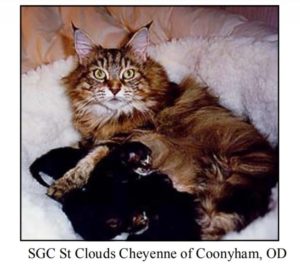
Silver Shadow (pictured) was a very dramatic, striking kitten. Nancy asked us if we’d consider showing him and when we agreed, she gave us a quick grooming I first met Nancy when I was assisting her with a Maine Coon rescue situation in Los Angeles. Over the years we forged a great friendship. I spent many nights talking with Nancy about some of her cat show escapades. She very much enjoyed showing her cats and the friendships she made along the way. When St Clouds Starfire presented me with his last litter, Nancy was in the hospi tal for a breathing issue. I was not sure she was up to the surprise, but I made the journey to LA with photos in hand. Nancy and I were in the gift shop talking about cats, when one of the gift shop associates asked us what a Maine Coon looked like. Nancy attempted to tell the associate what a Maine Coon looked like when I an nounced I had pictures of some Maine Coon kittens. I brought them out and when Nancy saw them she looked at me and demanded to know where I got these kit tens. She thought I got them without discussing them with her. When I told her they were Starfire’s, she started to cry and said they were tears of joy because her lines will be carried forward.

On Diamond Lil’s 16th Birthday. I had a cat food cake made and we had a birthday party complete with hats and horns. I told Nancy the one thing I wanted was a professional photo of herself and Lil. Nancy told me I could take Lil to get her picture taken but she was not going to be in the photo. Several weeks and discus sions later, I took Lil to a show to get her picture taken and was so proud of my self for the guilt trip I laid on Nancy to get her to agree to be in the picture. When the proofs arrived, I showed them to Nancy and told her I was going to put this picture on the front page of a web page and call it Two Old Broads. Nancy, as usual had to have the last word, and corrected me, the title should read Two Grand Old Broads!

Nancy was a great mentor and I will miss our discussions about the loss of boning and breadth of chest in our breed. I think the one thing she would want to pass onto other breeders is to strive to maintain the wonderful personality of these lesson and later sent detailed instruc tions on exactly how to show a kitten – from cage curtains to show eti quette. She was so helpful and thor ough and ensured our first show ex periences were enjoyable. She cheered us on – every step of the way.
Once we decided to move to the next step beyond showing – breeding, Nancy sold us a proven queen (Sierra Nevada) and recommended a breeder friend of hers for us to con tact for a second female. She was our MCBFA sponsor and remained close to us. Her eye for type and potential was phenomenal – she could determine from a glance the pick of any litter. Nancy’s lines were so helpful to other breeders who needed great temperaments, large ears, lovely coats and clear silver coloring. You could tell just by look ing which cats at a show had St Clouds in their backgrounds.
We still have our cherished Rhiannon – daughter of Silver Shadow and Si erra Nevada (pictured), who with those gorgeous green eyes and sweetheart ways is our daily reminder of Nancy and her magnificent cats.
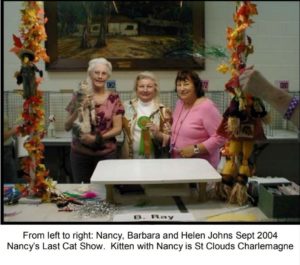
Willowplace On Nancy & How Many Famous Maine Coons Came To Be Barbara Ray, Willowplace cattery, South Carolina
Nancy and I officially met at the TICA Incats Madison Square Garden show in 1986.Nancy was showing a Diamond Lil daughter and I went to find her after her cat had three calls to the ring. We struck up a conversation and enjoyed each other’s company. We continued to keep in touch and met at shows from then on and became the best of friends forever.
Often we did not meet but three or four times a year as I live on the east coast and Nancy on the west coast. I visited Nancy’s home several times. She lived in what I call a Frank Lloyd Wright style home, high in the hills of Los Angeles. She lived there with her beloved son Mark, who was grown. She told me she had selected the house because it was very near Mark’s school. At the time we met, she was head of social services for Los Angeles County. She was a psychologist and often gave her time to people who needed help.
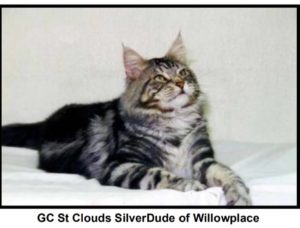
There were always beautiful cats walking around the house and Napa Valley Moonshine, Nancy’s stud, lived in the sunroom which was in the center of the house and near everybody. In 1989, Nancy sent her Saint Cloud’s Burnt Sugar to breed my Willowplace Starbuck and had Saint Cloud’s Starfire that she also kept as a breeding male and several other outstanding kittens from that litter. Laura and Sharon Cunning ham, Coonyham cattery, purchased a beautiful brown classic female, Saint Cloud’s Cheyenne of Coonyham,from that litter.
She had a favorite restaurant, a Mexican restaurant that friends of hers owned. At the time it was the best Mexican food I had ever eaten. When I was visiting her sometimes we would go two nights in a row. Whatever we did we always had a good time and laughed a lot. Nancy sent several outstanding Saint Clouds kittens to Europe for breeding. Some of those breeders had some contact with me and I know she was very well respected by the European breeders and they loved her cats with their style and type. They kept in touch with Nancy in a very friendly way.
The last time I spent a great deal of time with Nancy was at the TICA World Show in Los Angeles in 1991. It was a very large event and brought breeders and exhibitors from all over the world. Nancy had sold a beautiful blue-silver male kitten to Betsy Tinney, Pinecoon cattery, in Washington state. Betsy sent the young male to Nancy for the World Show and while visiting Nancy before the show (I was exhibiting, not judging) we had a good time bathing and grooming him as we visited.
Nancy liked my Hillside Mr. Spock of Willowplace very much. We were discussing Nancy sending her beloved Diamond Lil to breed to Mr. Spock. As plans were finalized, Nancy had heard that Lynne Sherer, Calicoon cattery, was offering her Calicoon Prince Valiant for stud to selected breeders for a short period of time. She asked me what I thought about her sending Diamond Lil to Prince Valiant for breeding. We decided it was a great idea and that I should get a silver female from this breeding. Well, Nancy did the breeding, and guess what….there were no silver girls, just brown girls! There was a silver classic male in the litter. I was not sure I needed another male for breeding I had Spock and Starbuck, but Nancy and I kept talking and finally we decided to have Nancy send the silver boy to us for breeding. After Nancy put the silver Prince Valiant/Diamond Lil boy on the airplane, she telephoned me and told me to expect a surprise when I received the car rier. Nancy had also sent a brown classic female littermate with the silver boy. She felt I needed both for my breeding program. Dorothy Robinson, Seascape cattery, in Maine was looking for an outcrossed female to breed to her male stud, Willowplace Argus of Seascape. After I received the silver boy and brown girl, Nancy and Dorothy got together and sent the beautiful brown tabby female to Dorothy for Argus.
Nancy had saved the name Saint Clouds Silver Lining for a very special cat. Nancy and I discussed that this silver boy she had sent to me might be a Saint Clouds Silver Lining. As the weeks went on and we decided that he was a Saint Clouds SilverDude-a surfer boy who came from California. SilverDude was a breeding cat at Willowplace for nine years and an outstanding character! We thank Nancy and Lynne for this won derful boy with the very diverse pedigree. Saint Clouds SilverDude has played a part in breeding programs all over the world.
The last time I saw Nancy was in September 2004 (picture on page 11) at the San Gabriel Cat Show in Ar cadia, California. Nancy looked great! With us in the photo is Helen’s International Winner St Clouds Charlemagne, a beautiful blue-silver kitten that I had used as my best Maine Coon kitten and my best All breed kitten. They later told me that this boy is a son of Cree’s Junior (SilverDude’s grandson and his mother is Saint Clouds Gabriella- a granddaughter to Helen’s SGC Pedropurss Sirius Star and a Starfire granddaughter). Gabriella now resides with Nancy’s friend, Helen Brandenburg, in the Phoenix area.
Nancy sponsored new breeders of Maine Coons and she worked with established breeders. Nancy was always willing to listen and assist. Nancy will be greatly missed.
CONNIE CONDIT revisited
With thanks to Sherry Lane Jones (PURROCIOUS Maine Cos USA), Simone Muehlfeit (TARA Maine Coon Germany) and Ken Shindler (HLLSIDE Maine Coon Canada) for the pictures

Heidi-Ho was founded by Many M. (Connie) Condit, and included two foundation cats, Andy Katt and Bridgett Katt.From that beginning Connie built a line which is famous for passing on it massive size and bone wonderful shaggy coats and thick lynx-tipping.

Connie was one of the early members of MCBFA, and the cats of Heidi-Ho Maine Coons have played a large part in so many lines, but many of us have never had the opportunity of seeing any of these cats in person.
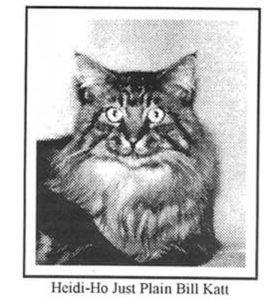
Breeders talk about the «ciones» but many people don’t know that term refers to kittens out of Heidi-Ho Sonkey Bill and Tanstaafl Pully Adeline of Heidi-Ho. This pair produced offigring all of whom had the same signature » look’ (leadingpeople to claim that Connie was cloning them?) which survives in their descended today.
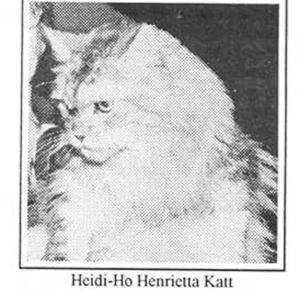

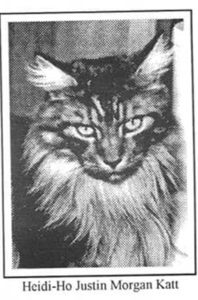
Although Connie has not been breeding Mane Coon for the last few years, her cats are still a powerful influence in lines As Ken Shindler of Hillside Maine Coons once said, «If you don’t know where you came from it’s hard to know where you’re going»
The Scrath Sheet -spring 1993
CONNIE CONDIT Heidi -Ho
by Cheryl M. Gower with photos, pedigree information. and a telephone interview with Ms. Condit by Patsy Stephens.Napa Valley Cattery
Mary M. Condit, nicknamed «Connie» as the military is wont to do,was a Lieutenant Colonel in the U.S. Army, and stationed in Washington, D.C. As a nurse at Walter Reed Hospital, she and several other nurses roomed together in a dormitory on base. One chilly Spring D.C. night in 1969, a very pregnant cat strayed up to the dormitory door. Connie, the ultimate animal lover she is, took herin. It wasn’t long until she presented the nurses with a litter of four male kittens. Among them was a brown mackeral tabby w/white, tall ears, the only longhair in the bunch. Connie kept him and dubbed him Andy Katt. Homes were found for the others, and the nurses pitched in to fund his mother’s spay surgery.
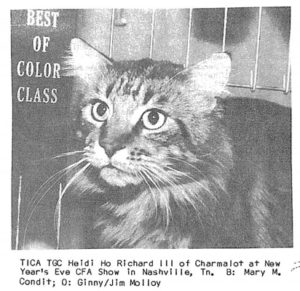
Andy and Connie moved to Maryland, where someone told her that Andy looked like a Maine Coon. Herinterest stimulated, she registered Andy in ACA (American Cat Association) on the advice of Susie Page. Andy was shown in ACFA and achieved his Cham pionship and Grand Championship before the age of nine months. Afriend, Bonnie Rich (DeRichelieu Cattery) found a smoked tortie w/ white kitten and small ears in Florida, and gave her to Connie. We know heras Bridget Katt. This kitten’s mother was a black w/white, but the father is unknown.
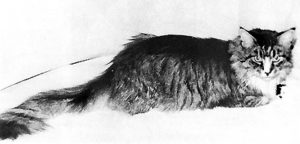
Connie, Andy and Bridget moved to Colorado in 1970. She named her cattery «Heidi Ho» after her German Shepherd dog of the same name. This dog tolerated the cats with much tionen accod all the kitten births so it only seemed fitting.
Bridget and Andy produced:
- Heidi-Ho Jason Katt (brownmctabby w/wht.male)
- Heidi-Ho Kukla (silvermctabby female 8-5-70)
- Heidi-Ho Zacharius Peabody of Sundar (shaded cameo male)
- Heidi-Ho Fanny Abigail
- Heidi-Ho Red Jed
- Heidi-Ho Heather
- Heidi-Ho Henry Sayward
- Heidi-Ho Molly Stark
- Heidi-HoSeth Parker
Andy was neutered at nine months, because he had an chronic intestinal bacterial problem. It was Andy who carried the strong genes for the Heidi-Ho look.
Then Molly Stark was bred to Seth Parker (a brother/sisterbreeding), which produced:
- Heidi-Ho Georgie Girl of Ktaadn.
- Heidi-Ho Josie of Tanstaafl
- Heidi-Ho Noah of Miston
- Heidi-Ho Rickshaw of Quanyin
The next combination between Molly Stark and Henry Sayward (a brother/sister breeding) produced:
- Heidi-Ho Cassandra of Furr-Ever
- Heidi-Ho Peaches
- Heidi-Ho Luke of Cosy Nook
When Connie was transferred to Germany, Andy, Bridget, Heather, Henry and Seth all traveled with her. She had a few litters, only to keep them in good health. As retirement from the service drew closer, Connie decided to settle in Colorado, living a rather private life in a mobile home with fenced-in yard. Her cats were allowed outside to romp in the snow, safe in side their enclosure.
In her continued quest for breed excellence, and her ongoing test to make sure Andy’s intestinal problem was not hereditary, Connie bred Henry Sayward to Heather (another brother/sister combination). They produced:
- Heidi-Ho Heathcliffell
- Heidi Ho Henrietta Katt
When Henrietta came of age, she was bred back to her father, Henry Sayward.
They produced the very famous Heidi-Ho Sonkey Bill and Heidi-Ho Georgie Caroline.
Recognizing that it was indeed time for an outcross, Sonkey Bill was bred to Tanstaafl Polly Adeline of Heidi-Ho. Their progeny are what have become known as the «clones», because they all looked so consistently alike. With the type so firmly set from prior generations, «clones» were a surefire result. Their offspring include:
- -Heidi-Ho Wilyum of Ktaadn
- -Heidi-Ho Percival of Meunerie
- -Heidi-Ho Canth of Tanstaafl
- -Heidi-Ho Coon Victoria of Purricoon
- -Heidi-Ho Sasquatch of Ktaadn
- -Heidi-Ho Lady Arwen of Mary B
- -Heidi-Ho Richard III of Charmalot
- -Heidi-Ho Aurora of MtKittery
- -Heidi-Ho Just Plain Bill Katt
- -Heidi-Ho Justin Morgan Katt
- -Heidi-Ho Camille
- -Heidi-Ho Rachael Adeline
- -Heidi-Ho Lovey Mero of Meunerie Tanstaafl Molly Brown
Heidi-Ho cats were big-boned and heavily coated, and as you can see in the photos, they had broad, square muzzles. Connie invites anyone who doubts their coating, to come to Colorado to help comb them out. She says that if a Maine Coon can’t take the rigors of a Maine winter, then it is not a Maine Coon. Asked «What does a judge go forina Maine Coon», the hair on the back of herneck visibly rises as she answers, «Who cares what a judge ‘goes for, you’re supposed to be breeding toward a set standard. Amen!»
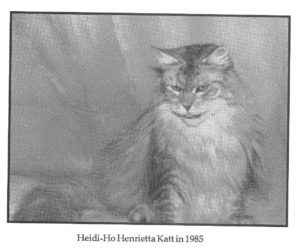
Looking back on Andy’s intestinal problem, Connie has used her extensive medical knowledge to study and realize that some times these things just occur. The same thing goes for cats with a chronic eye inflammation and discharge(usually the right eye). They don’t seem to pass it on; you keep it under control with antibiotic ointments, and the animal just lives with it. Some accuse the Heidi-Ho line of massive cardiomyopathy, but one must remember that cat foods were not the caliber they are today; the necessity for taurine was not known nor used as an additive back in the early ’70s.
Mary M. Condit forged out on her own, beginning with breeding in 1992. Justin Morgan and Polly Adeline (both 18yrs. old, deaf and with no teeth; and Just Plain Bill Katt and Rebecca (both 16 yrs.) are still living and enjoy the Colorado snowy winters. Copnnie currently has a one-year old male Maine Coon and is looking forward to showing him. If you’d like to write to her, the address is 30575. Kearney St, Denver CO 80222. Phone 303-979-65771
THANK YOU, CONNIE, for all you’ve done for our breed.
Scratch Sheet 1995 MCBFA
Alma and Ken write:

Born in 1983 in Denver, Colorado, Dani is probably the last of the Heidi-Ho «clones.» She was first acquired by Brooke and Herb Berger (Purricoon) of St. Louis, MO. She then moved to us in Canada.
She is the dam of GC Hillside Mr. Spock of Willowplace, OS and through him the grand-dam of many large, feral-looking, and honored Maine Coons on three continents. Her «wild» look has caused alarm several times in her lifetime. She looks more like something that just came out of the woods after prey than a fireside puss!
Dani is now living in contented retirement with Nancy and Karl Frey, where she passes her days watching birds at the feeder and the wildlife that periodically comes out of the woods behind their home near Blackstock, Ontario. She also sometimes visits with her old friends, Alma and Ken, and her many Hillside descendants.
ALMA & KEN SHINDLER Hillside
Canadian Breeders—featuring Ken & Alma Shindler
It all began in 1978 with the arrival in Canada of a solid blue longhaired kitten with an aristocratic bearing named Azure. He had been bred by one of the founding members of MCBFA, Betty Ljostad. His father was an Illya cat and his mother had been dropped off with Betty by «Connie» Condit on her return from her last German posting.
Azure had been sold to Alma and Ken Shindler to be shown as an alter and he was. He also held a unique if unenviable claim to being almost the only Maine Coon in eastern Canada (the other was owned by the US Ambassador to Canada, a Carter administration appointee and, appropriately, the former governor of Maine). Ljostad Azure of Hillside showed mainly in CCA against Persians and Himalayans and held his own.
After a few years of showing their alter, Alma and Ken decided to try their hand at breeding. A side trip to Philadelphia after a CFF show in New Jersey resulted in a blue female kitten named Mladia Amethyst of Hillside, and shortly after there arrived from Pittsburgh a blue male, Rokote Indigo of Hillside who was pure Whittemore Norwynde. Hillside Maine Coons was born.
The appeal of the blues waned after a while and the line was supplemented by a series of acquisitions from Charmalot, first a blue tabby female, then a brown tabby female, then a brown tabby male, all sired by Heidi Ho Richard III of Charmalot, of fond memory.The next big break came when Alma and Ken went to a TICA show in Dallas in 1987 and met Vickie Fisher, then a new breeder who was showing Richard’s son, King Arthur Pendragon. The result next spring was the arrival in Canada of Pendragon’s son, Coonquest Beaujolais of Hillside, a beautiful brown classic tabby.
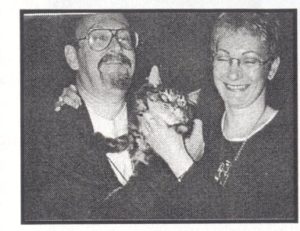
«Beau» was an immediate hit in CCA, becoming a Grand at 10 months and a Master Grand at 14 months (CCA scoring is much like CFA). At the end of the show year, Beau was CCA’s 3rd Best Cat. He could have been first, but Beau had decided that he did not want to show anymore and had been withdrawn from the last three rings of the show year. He then settled down to siring kittens.Earlier, while spectating at an ACFA show in Florida (their annual Spring «thaw-out» trip) Alma and Ken met Brooke and Herb Berger. The Bergers had a Heidi Ho female who was too feral for their taste and sold Danielle Coon to the Shindlers.
Dani» was (and still is) a magnificent cat. She was one of the last of the Heidi Ho «clones», feral, almost black in color, big-boned, long ,bodied, square-muzzled, tall ears and a look that could stop a barn rat’s heart at twenty paces. Mated to Beau, she reproduced herself for years.
But the Canadian Cat Association likes flash in its Maine Coons. It likes sweet-faced cats with warm tabby markings, hopefully with white, with moderate lines. The result was that most of Daniand Beau’s kittens were sold as pets.
Then, in 1989, Dani had what was to be her last kitten. He was an only kitten, a vigorous six ounces at birth, a reproduction of his mother with tall lynx-tipped ears. He had to be named «Mr. Spock».
Alma and Ken took him to the Boscats TICA show in Boston that year. The cat that had been dumped by the CCA judges granded immediately. They then entered him in the new TICA show near Montreal. Barbara Ray was a probationary judge and handled the growling Mr. Spock (no natural show cat he). A week later she phoned.

«I must have that cat» she said, «Can we work something out?» Alma and Ken knew and respected the results of the Willowplace breeding program. They also knew that Barbara Ray, living and showing

where type was more important than flash, could do more with Mr. Spock than they could in Canada. A trade was arranged. A Starbuck/Alexis female plus other considerations, went north to Canada and Mr. Spock went south. The rest, as they say, is history.
Before he left, Alma and Ken bred Mr. Spock to several females to retain the «look». In effect, the Shindlers now breed two lines of Maine Coons–the sweet-faced, moderate cats for their CCA/CFA customers and the more feral line for TICA-oriented breeders.
While not major players in the field (it is still an in-house hobby) the Hillside name is known and respected in Europe and North America. In addition to the U.S., there are Hillside Maine Coons in Germany, Austria, Denmark, the Netherlands and France. They breed only brown tabbies in both classic and mackerel patterns, with and without white. The occasional blue tabby is produced. There are eight breeding females and three males. Beaujolais is still active and is backed up by his grandson Mission Impossible (Mr. Spock’s son), and Islandcats Tarheels of Hillside who provides an outcross.
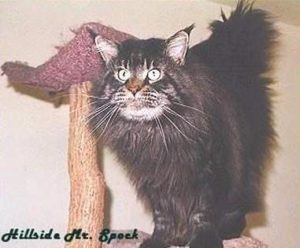
Ken retired from the Canadian federal government several years and now works on contract at home. Alma is employed with the Canadian Defence Department. Ken is a former director of the Canadian Cat Association and manages the occasional local cat show. They mostly show in Canada with an occasional foray to a TICA show on the eastern seaboard to stay current with what the mainstream of the breed is doing.
Scrath Sheet 1995-winter MCBFA
ADVENTURES TRAVELLING WITH MY CAT By Ken Shindler, HILLSIDE Maine Coons
I have often thought that it would be interesting to collect and publish stories told by people who have travelled with their cats. Especially people travelling to and from cat shows. Some of these stories would make your hair stand on end!

Like arriving in Edmonton to find that those nice airline people have sent your show cat to Winnipeg. Like arriving at the «show hotel» and having the hotel management not only deny knowledge of the show but decline to accept your cats.
Or arriving at the show hotel in Dallas late on New Years Eve and finding that because of the Cotton: Bowl being played the next day, a number of guests have not checked out and you are only one of a busload of people and cats looking for a to lay their weary heads.
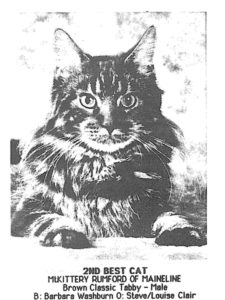
Or after that same show, finding same that the airline has never heard of you and can’t accommodate more animals on the flight anyway and that you will have to smuggle your (in our case, to Canada).
While our primary area of show activity is with the Canadian Cat Association, Alma and I make periodic forays into «TICA country» to show the flag, see where the breed is going. and do some dealing with other breeders.
On December 31, 1987 we left for Dallas, Texas for a two day show, travelling via Toronto and Chicago.Our travel agent had fouled things up and the airline had no record of us.

We were able to get seats for ourselves on the next morning’s flight but they could not accommodate our cats. Desperate measures were called for.
A quick trip to the boutiques, credit card in hand, produced two of those cute shoulder bags with airholes for kitty breath. We would cope. On arrival at the Dallas Airport in the wee hours of Monday morning, we decided to check in and travel.
New Year’s Eve we with other Eve was celebrated with many other cats in the Holiday Inn bus, all day in bus, but eventually everybody was bedded dow here down somewhere. We We had come with one male cat and were were taking delivery of a female kitten from Fran Lloyd (sent from Chattanooga, TN by way of Atlanta, our cats are better travelled than humans), most en Sunday afternoon, during a lull in the show, I called the airline to confirm our reservations.
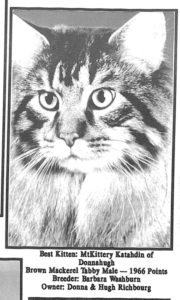
New Year’s Eve was celebrated with many other overtired people and cats in the Holiday Inn bus …separately so that if one was dis covered at least the other would hopefully get through. Alma took the kitten, and I the adult. I will never forget the look on the security agent’s face when he saw a skeletal cat Saw passing through his x-ray machine. Still pretending we didn’t know each other,
Alma chose a scat at the rear of the aircraft and sat at one end of the waiting room. I sat at the other end with will a pass for a seat at the boarding pass front of the the airplane.
The trip to Chicago was uneventful but on «deplaning» I found that our connecting flight was at the other end of the terminal. Less she lose her way of the tent in the labyrinth that is the O’Hare Terminal, I waited for Alma at the at the foot of the ramp and made sure that she could see me. Then like two spies in a bad movie, we made our way to the connecting flight, I in front, she following ten feet behind.
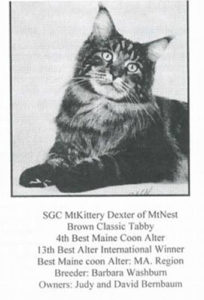
It was not until we reached Toronto that we could breath easier and acknowledge each other’s exis tence. In Canada, the security people work for the airlines, not the terminal, and we knew that our shoulder bags and we were not legal so we legitimized the process. A detour to the customer process. A detour service counter resulted in the of chase of one of those grand awful Air Canada plastic carriers and the cats were checked through to Ottawa. The fool behind the counter insisted on charging us double (because there were two cats in the carrier) but I later got refund and an apology from Air Canada.
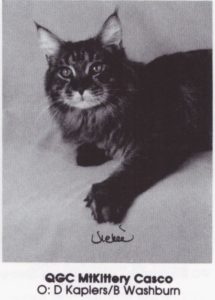
That was one weekend we were glad to see behind us.
The TICA show held annually at the Madison Square Garden in New York is an experience in itself. Not an necessarily an experience you will want to repeat, but an experience nonetheless.
If you like a show with lots of promotions and freebies, this is the show for you. If you like a show with wall-to-wall people, this is the show for you. If you like having your ving your pocket picked on the way to the show ring, or having to hide the water dish lest a spectator squeegee in some antifreeze to poison your cat, or having to make sure someone sits at naving the cage at all times lest your cat be stolen, this is your show.
The rings are set up back-to-back with a sort of tunnel in between. When called, cats are brought up in their carriers to the open end of the tunnel where a security guard allows only exhibitors with cats to pass. You then enter the ring from the rear, put your cat in the cage, retreat back to the tunnel behind the curtain, sit on your carrier and wait until the class. has been judged.
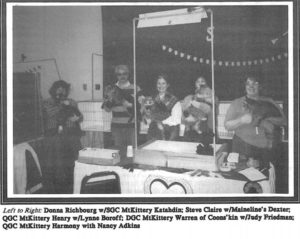
La Guardia is really an old fashioned airport. From the departure spons lounge, you can see bags, etc. being aded into loaded into the plane just below you..
Not seeing our carrier, I asked the passenger agent to phone downstairs to enquire if they were loading our cat. A few minutes later, he came over, asked toutes late to see our tickets and boarding passes and took them away. A moment later he was back.
«I’ve changed your seating,» he said. «You now have seats A and C. You will find your cat in seat B.» Sure enough, when we boarded, there was big Beau in his carrier strapped securely into seat B.
But more to the point, my tale is captain and several of the cabin about the trip home. We arrived at attendants were cat lovers also, and La Guardia Airport on Monday morn- before we took off, all had opened ing, left Beaujolais in his carrier at the their wallets to show us photos of cargo office and went to the departure their own feline friends. lounge. LaGuardia is really an old … when we boarded, there was big Beau in his carrier strapped securely into seat B.
The flight would continue to Ottawa but first put down in Montreal for customs and immigration clearance.

Anyone who has travelled through Dorval Airport from the U.S. knows that long trek through the tunnel to the customs hall, along the length of the terminal and back through another tunnel to the aircraft. But first there was this security man.
«Animals cannot travel in the cabin, monsieur,» I was told. «You must go back and put it in cargo.» This cat, I advised him, has permis sion from the aircraft’s captain to travel in the cabin.

«Non, c’est impossible!» he replied firmly. I I was faced with petty bureaucracy in all its rampant glory. I pointed to his telephone and told him call the gate and and speak to the captain himself. Grudgingly he did so and after a very terse telephone call, we were waved resignedly through, cat and all. As we boarded, the door to the flight deck opened and the captain gave us a thumbs up and grinned broadly. And that is how Beau flew back to
Canada, sitting proudly on a cabin seat, just like people!
MASAITANA MAINE COON
I love nature and animals. Upon my return from Kenya where I was struck by the vastness of nature and its savage beauty, I saw a photograph of a cat in a magazine. That cat was the Maine Coon.
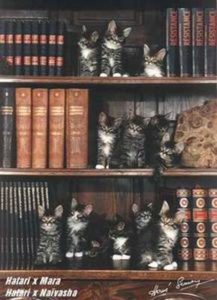
» Masai » arrived a year later and is now 13 years old. I looked for a playmate for him and, like Masai, I found Tana in France. MASAITANA MAINE COONS was born. As you can see, my MCs are named after regions, mountains or lakes in Kenya or Tanzania, or have Swahili names ( the language of east Africa).
The first litter followed a scathing comment by my vet. When Tana was on heat I asked him the best way to stop her having kittens. He said, «Get them both chopped and be done with it!» From that moment MASAITANA Maine Coons started. I let nature take its course and changed vet!

All my other MCs arrived from the USA because I realised very quickly that I wanted my cats to be well structured, have a wild look, powerful muzzle, and a strong chin. In short, to have the body and head in perfect harmony. I then had a stoke of luck. I met a breeder of Birmans, with whom I have been friends ever since, who put me in contact with Vickie Shields, a TICA judge. She gave me valuable advice and everything followed on from there.
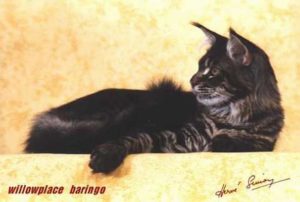
I met Barbara Ray who gave me the MCs with the look I wanted and sponsored me to become a MCBFA member. I supplied her with Masaïtana Haut Brion who went on to become a TICA Supreme Grand Champion in America. Finally, I couldn’t have wished for better kittens. For all these things I owe a debt of gratitude to Barbara.
With regards to hygiene, I established strict rules from the start :
– No cat to be mated with one from an outside cattery.
– Quarantine for each new arrival from outside the cattery.
– Heart ultrasound and hip X-rays for each new arrival.
– Systematic and regular cleaning and disinfecting of the house and exterior play areas (floors, rugs, litter trays etc) with hospital bactericides and fungicides.
– The weighing of all the cats (kittens and adults), every Sunday morning.
– Living area expanded to accommodate each new arrival to avoid overcrowding.
The other very important issue for me is to respect the authentic and rustic character of the MC in order to preserve his exceptional nature as one of the characteristics of the breed. My main aim is to produce beautiful kittens endowed with this marvellous character. In my breeding programme there is no place for «mass-production».

After all these years, one of my greatest pleasures is to see the Masaïtana » offspring » living in different areas of the world – numerous European countries (not subject to quarantine regulations), Malaysia, South Africa and the USA. I love to receive news of them all. The welcome feedback I receive from my kittens’ new owners only encourages me to continue my efforts on behalf of the race that I love so much.
© 2021 Berkano Cattery – All material on this site is copyrighthed and many not be printed or reproduced, in any form,without the express writen consent of Berkano Cattery.
Página desarrollada con ❤ por Cattery Web.
